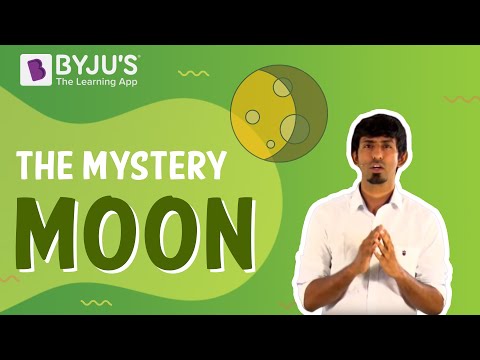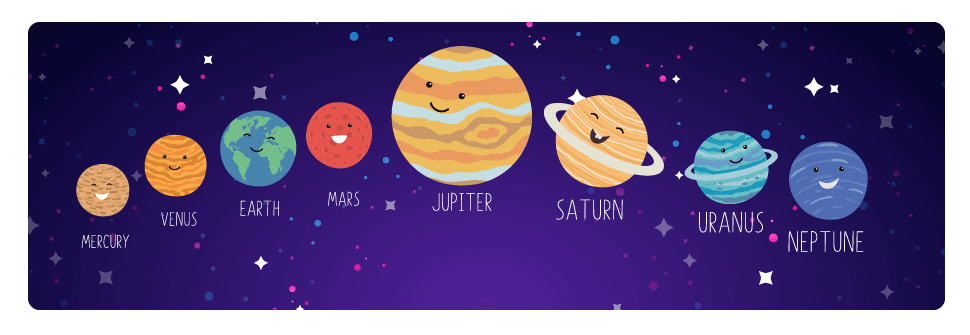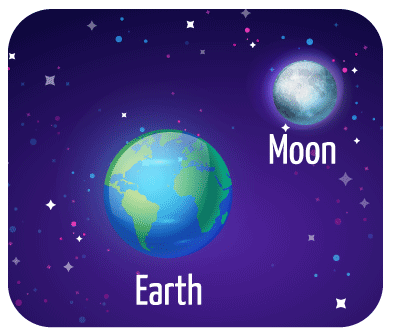According to the CBSE Syllabus 2023-24, this chapter has been removed from NCERT Class 8 Science textbook.
The planets, the stars, the moon and other bodies in the sky are known as celestial bodies. Astronomy is a branch of science that studies celestial bodies and the associated phenomena. The change in the shape of the moon every day is one of the observations of celestial bodies that we can make. The day on which the whole disc of the moon is visible is known as the full moon day, while the day on which only a small portion of the moon is visible is known as the new moon day. Various shapes of the bright part of the moon seen during a month are known as the phases of the moon. The phases of the moon occur as we can only see the part of the moon that reflects the light of the Sun towards us.
Phases of the Moon
Moon and its Different Phases
– The various shapes of the illuminated part of the moon as seen from the Earth are called the phases of the moon. The cycle is about 29 days, and it goes from a full moon to a new moon to a full moon.

Understanding Phases of the Moon
– The moon does not produce its own light but reflects the light of the Sun. As the moon revolves around the earth, different parts of its surface get illuminated, and we see a different shape every day.

For more information on the Mystery Moon, watch the below video

The Dark Side of the Moon
- The part of the moon that always faces away from the Earth is called the dark side of the moon.
- The moon’s time period for rotation on its axis and revolution around the earth is approximately the same. (≈ 27.3 days). Therefore an observer always sees the same face of the moon from Earth.
For more information on the Dark Side of the Moon, watch the below video

To know more about the Dark Side of The Moon, visit here.
Surface of the Moon
- The surface of the moon is barren and dusty and devoid of water. It has many large craters and high mountains.
- The moon’s gravity is six times weaker than Earth’s gravity. It is so weak that it does not have any atmosphere. That is why we cannot hear on the surface of the moon.
To know more about Moon, visit here.
Stars
- Stars are celestial bodies that emit their own light and heat. Our sun is an example of a star.
- Although stars are always present in the sky but are only visible at night due to the absence of sunlight.
- They appear as points as they are millions of kilometres away from us. Stars twinkle as their light gets refracted in our atmosphere.
- The position of stars keeps changing as seen from the earth’s surface, apart from the Polestar, whose position is fixed.
For more information on Stars, watch the below video

To know more about Stars, visit here.
Pole star
- The Pole star (or Polaris) is one star whose position seems to be fixed. All other stars seem to move around the Pole Star.
- It can be traced using the constellation Ursa Major.

Light year
- The distance travelled by light in one year is called a light year. It is a measure of distance for celestial objects.
- Speed of light \(= 3 \times 108 m/s\)
- 1 light year \(= 9.46 \times 1012 km\)
- The sun is 8 light minutes away from Earth.
- The distance of Alpha Centauri is 4.3 light years away.
To know more about Light Year, visit here.
Constellations
- A group of stars that form a recognisable shape in the night sky is called a constellation. They were devised by ancient men for navigation purposes.
- Examples: Ursa Major (Great bear), Orion, Leo Major

To know more about Constellations, visit here.
Introduction to the Solar System
Celestial Objects
– A naturally occurring physical object in the cosmos, outside Earth’s atmosphere, is called a celestial body. For example, Sun and moon

The Solar System
- The sun and all other planets and celestial bodies that revolve around it are together called a solar system. Our solar system has 8 planets and an asteroid belt. Pluto is considered a dwarf planet.
- All planets in the solar system revolve around the sun in fixed orbits. Planets nearer to the sun revolve faster as compared to the planets away from the sun.

The Sun
- The sun is the nearest star to Earth. It is continuously emitting heat and light.
- It is the main source of heat and light energy for all planets in our solar system.
The Planets
- Planets are celestial bodies that do not emit heat or light of their own.
- They revolve around a star in fixed paths called orbits, and the time it takes to go around the sun once is known as its period of revolution.
- A planet also spins on its own axis, which is called a rotation.
Our Solar System
Orbit
An orbit is a fixed path that a planet takes to revolve around the sun.

Mercury
- Mercury is the nearest planet to the sun and also the smallest planet in our solar system.
- It is usually hidden due to the sun’s glare but can be seen just before sunrise or after sunset.
Venus
- Venus is the brightest planet in the night sky.
- It is the closest planet to Earth.
- Although not a star, it is called the morning star or evening star as it appears in the eastern sky before sunrise and in the western sky after sunset.
The Earth
- The Earth is the only habitable planet in our solar system. Life exists on Earth due to several optimal conditions, like the presence of the atmosphere and water and the right distance away from the sun.
- The earth appears bluish-green from outer space as light from the landmass and water bodies gets reflected.

- Earth has only one natural satellite: the Moon.
- The earth’s axis of rotation is tilted, which causes seasonal variations.
Mars
- Mars is the 4th planet from the sun. It is often referred to as the “Red Planet” because the reddish iron oxide prevalent on its surface gives it a reddish appearance.
- Mars has two natural satellites.
Jupiter
- Jupiter is the largest planet in our solar system. So big that it can accommodate 1300 planets like the Earth. However, it is only 318 times heavier than Earth.
- Jupiter has at least 67 moons.
- Jupiter has a big red spot which is a gigantic storm that has been swirling for many years and is twice as wide as Earth.
Asteroids
- Asteroids are a large number of small celestial objects between the orbits of Mars and Jupiter.
- They revolve around the sun too in their orbit.
- Asteroids together form a belt.
Saturn
- Saturn is the second largest planet in our solar system. It is unique as it has thousands of beautiful rings.
- Saturn has a large number of moons.
Uranus and Neptune
- Uranus rotates from west to east. Its axis has a huge tilt which makes it look like it’s spinning on its side.
- Neptune is the 8th and farthest planet in our solar system. It has really strong winds, which are more powerful than any other planet in the solar system.
For more information on Pluto and Ice Giants, watch the below video

To know more about Solar System, visit here.
Comets
- Comets are celestial bodies that revolve around the sun in long elliptical orbits. They are usually made up of ice, dust and gasses and have a very long tail that is always directed away from the sun.
- As a comet gets closer to the sun, it heats up and spews out jets of gas and forms a huge glowing head.

Meteors and Meteorites
- Meteors are small objects, mainly leftover broken asteroids, that enter the Earth’s atmosphere at high speeds.
- The friction between the atmosphere and the meteor causes it to burn and evaporate before it reaches the surface. That is why they appear as bright streaks of light in the sky.
- Sometimes when a meteor is large and does not evaporate in the atmosphere, it strikes the surface. This is known as a meteorite.
To know more about Meteors and Meteorites, visit here.
Artificial Satellites
- Artificial satellites are man-made objects that are launched from Earth and revolve around the Earth much closer than natural satellites.
- They are used for various applications like remote sensing, weather forecasting, and transmitting signals.
- Examples: INSAT, IRS, Sputnik -1
| Also Access |
| NCERT Solutions for Class 8 Science Chapter 17 |
| NCERT Exemplar for Class 8 Science Chapter 17 |
Learn more about the solar system, celestial bodies and other related topics, including NCERT class 8 Science notes, at BYJU’S.
Also Read:-
| Planet | Solar System |
Frequently Asked Questions on CBSE Class 8 Science Notes Chapter 17 Stars and the Solar System
What are the phases of the moon?
The moon phases in order are new moon, waxing crescent, first quarter, waxing gibbous, full moon, waning gibbous, last quarter and waxing crescent.
What is the meaning of Light year?
Light-year is the distance light travels in one year.
What are Comets?
Comets are cosmic snowballs of frozen gases, rock, and dust that orbit the Sun.
Comments